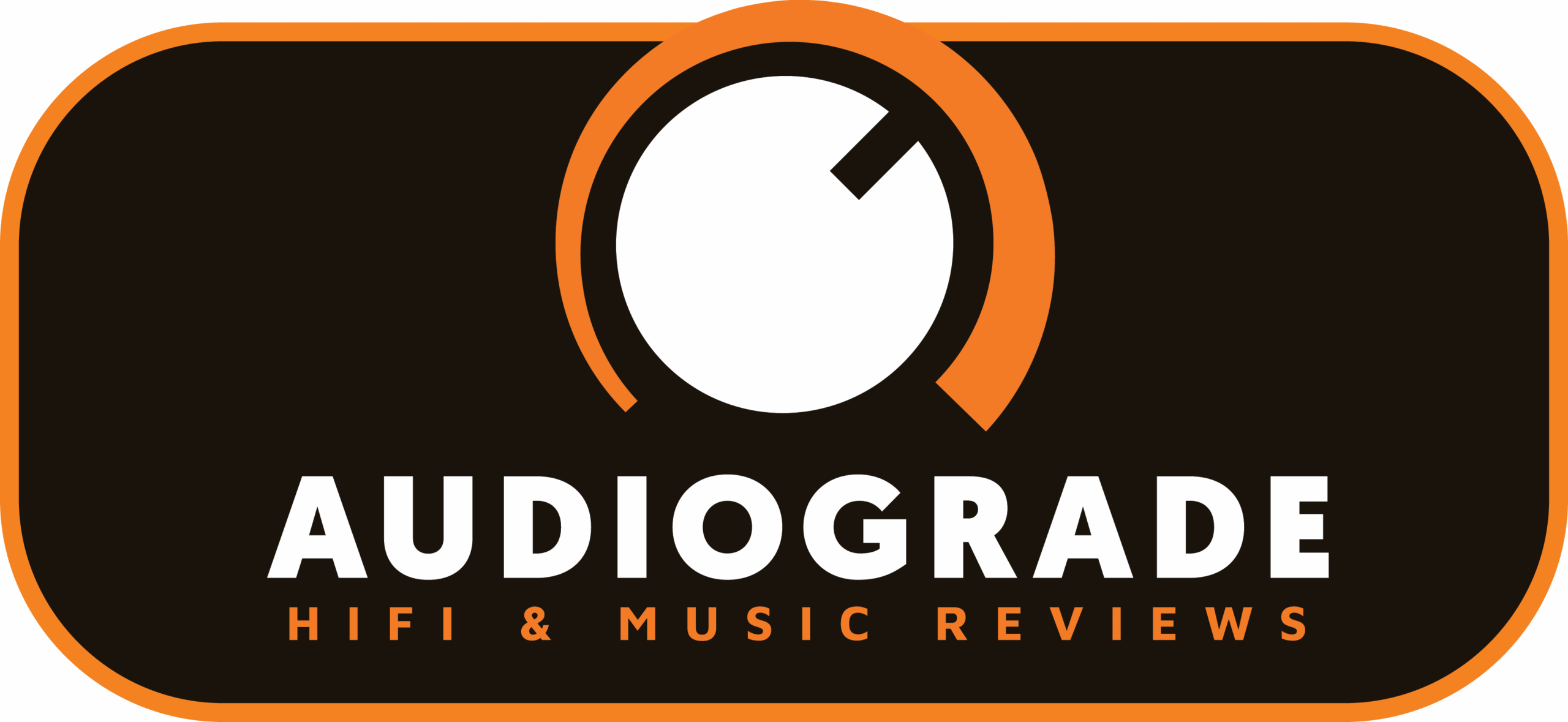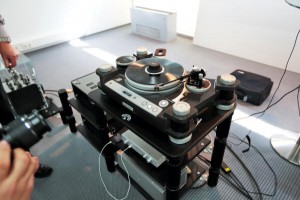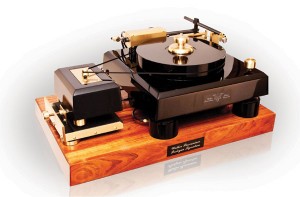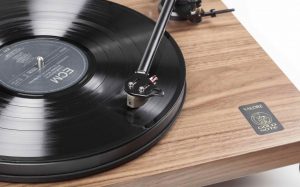A turntable is an area of engineering art balancing on the border between mechanics and electronics. This time, we will take a closer look at the product unique even among the best turntables: TechDAS Air Force III Premium Turntable Heavy, massive, compact, with a platter moving around on a thin film of air, with a vacuum holding down a record on the surface of the platter, a motor that by itself measures the belt tension, is a great example of engineering and Japanese precision of the highest order.
The naming of a new product may decide about its success. A badly chosen name, either strange, incomprehensible, or too far from what the company has been doing before, stigmatizes such a product. On the other hand, there are many too "technical" names of product in the form of numbers and letters—they are so impersonal that they are hard to remember. There are of course exceptions to this rule, for example Mark Levinson devices, but these are just exceptions. Sometimes they come back years later, like new versions of JBL speakers, but only because they have the status of "icons". And the icons are respected.
It's even more difficult for manufacturers and designers who want to interest us with their products that are not really so new, because they are a development of some existing products. There are two main methods for this: to come up with a completely new name or add something to the old one. In the first case, one breaks off with the model the new one is based on, in the other one binds both permanently. Both methods have advantages and disadvantages.
TechDAS Air Force III Premium Turntable
For a long time, the naming of Japanese TechDAS turntables was consistent and logical - at the top there was a State of The Art Ultra High End Turntable Air Force One (345 000 PLN), below there was a Ultra High End Turntable Air Force Two (158,000 PLN), and even lower in the lineup a High End Turntable Air Force Three (89,000 PLN, the company uses interchangeably names - "One", "Two" etc. and Roman numbers - "I", "II", etc.) . Last year, the youngest model, Air Force Five, joined this family. The logic was ironclad, because each model down the line cost about the half of the higher model.
It has changed with the introduction of upgrades for the top turntable—besides cosmetic changes and automatic feet pumping the most important change was the replacement of the platter. Model with those upgrades was named "Premium" and this Premium designation was added to the already existing name, which gave us: Air Force One Premium. The increase in price was significant and amounted to approximately 30%.
This is how Mr Hideaki Nishikawa-san, the company's chief engineer, explains the reasons for creating this version:
"The new premium model comprises improvements that result in further refining the sound, based on the compact Air Force III. Building on the success of a hugely popular model; the Air Force III, a turntable which has a compact sized chassis yet delivers very high performance and flexibility of installation. The new Air Force III Premium has integrated further new concepts for an even higher quality while retaining the same compact size."
source: techdas.jp
The new version of the Air Force III Premium turntable is different. On one hand, it is an obvious continuation and development of the idea behind the basic model, and on the other, something more. The main reason for the changes was the willingness to adapt the solution from the One Premium model, i.e. replacing the platter. In this case, manufacturer decided to use gunmetal, the alloy of copper and tin, once commonly used in audio. The new platter weighs 29 kg (old one, made of aluminum - 9 kg). So one should be ready for the total weight of the turntable amounting to 50 kg.
However, to adapt a heavier platter they had to replace the main bearing with a new, stronger one. So they changed the plate with the axle and the axle is now made to fit into the holes of the platters of different diameter—an extremely useful solution. The surface of the platter was precisely polished and gold-plated. An aluminum, black chassis weighing 18 kg is in turn anodized and polished to achieve a high gloss finish. However, it is still a similar design: mass-loader, without decoupling, with an external motor and drive belt. It differs from most turntables by other manufacturers, as already mentioned, by an air pump that lifts slightly the platter—by 30 μm—and sucks down a record.
The drive is provided by a separated motor. It is a synchronous motor, electronically controlled. The torque is transmitted to the perimeter of the platter using a wide, flat belt. Drive control was placed on the extended element in the base of the turntable—there is also a button to "suck" a record to the platter. The motor is positioned next to it, but the belt tension is controlled by the microcomputer system, which also monitors the rotation stability.
Also in this case there were some changes introduced—the pump housing is much larger than in the basic version, because it uses larger air tanks, which ensures better pressure stability. This is a high quality housing, and the whole looks a lot like an amplifier. A novelty is placing a circle on the front with glass and backlit TechDAS logo—exactly the same circle is used to close the motor compartment. The whole is placed on special, compliant feet.
The turntable can be expanded, for example with more tonearms—one could use up to four of them! Each new arm requires another base, and it costs PLN 6,800 per piece. The turntable comes without a record clamp, but one can buy it as a recommended option. The aluminum version costs PLN 3850, and a tungsten one costs PLN 18 850 (!). The set includes an acrylic platter cover, which costs PLN 1,200 separately. In a word—the deck is just the beginning.
So it's a turntable, which is only in part a continuation of the older one. In fact, it is a new model that fits between Air Force III and Air Force II in the lineup.
HOW DID WE LISTEN TO IT?
The TechDAS AIR FORCE III Premium turntable was placed exactly in the same spot as the Three and previously One and Two models. Because I listened to previous turntables with different tonearms, and the only constant was the Miyajima Laboratory Madake cartridge (PLN 23 900), I carried out part of the listening sessions with it. It was mounted on the tonearm, that I already listened to a few times on different turntables, i.e. 9'' Schröder CB (17 900 PLN).
Much more interesting, however, turned out to be another arm—a brand new, massive Kuzma 4Point 9 (PLN 15 300). The shortest of the 4Point series is, it seems to me, the best arm developed by Franc Kuzma. The Polish distributor, or its representative, Wojtek, as usually, set up the My Sonic Lab Eminent Ex cartridge (PLN 16,900) on it.
A signal from the turntable was fed to the RCM Audio Sensor Prelude IC phonostage, which I have been using for ten years, and also—interchangeably—to the Grandinote Celio IV. Then the signal was sent to the Ayon Audio Spheris III line preamplifier and then to the Soulution 710 power amplifier. The speakers I used were Harbeth M40.1, and the cabling; Siltech Triple Crown and the Acoustic Revive Triple-C. The records before I played them were cleaned in an ultrasonic Audiodesksysteme Gläss Vinyl-Cleaner.
SOUND
Records
- Hank Mobley Mobley’s Message, Prestige/The Electric Recording ERC023, "Limited Edition | No. 263/300", 180 g LP (1956/2016)
- Komeda Quintet, Astigmatic, Polskie Nagrania "Muza" XL 0298, "Polish Jazz Vol. 5", mono LP (1966)
- Paul Desmond, Take Ten, RCA Victor/Speakers Corner Records LSP-2569, 180 g LP (1963/2005)
- Sun Ra, The Futuristic Sound Of Sun Ra, BYG Records 529 111, LP (1969)
- The Art Ensemble of Chicago, Fanfare For The Warriors, Atlantic ATL 50 340, "That’s Jazz. Vol 27", LP (1974/1976)
- The Dukes of Dixieland, The Dukes of Dixieland, Audio Fidelity AFSD 9004, LP (1957)
- Tomasz Pauszek, LO-FI LOVE, Audio Anatomy AA-006-17-LP, 2 x 180 g LP (2017)
- Tommy Dorsey & Frank Sinatra , The Dorsey/Sinatra Sessions Vol. 2 (July 17, 1940 - May 28, 1941), RCA Records CPL2-4335, 2 x LP (1982)
- Yuri Tashiro Piano Trio, Aiji Arai & The Beat Sounds, Digital Explosion, EastWorld EWJ-80181, "Soundphile Series (Digital Recording)", LP (1980)
I have been having this recurring bad dream, maybe even a nightmare, in which the device that I thought was the best of the best played my favorite records so that I did not want to listen to them. I most often dream it when I am about to get, or already have received a turntable for a review. Contrary to the popular belief of music lovers and some audiophiles, the turntable is not a remedy for the bad things and it is really easy to "spoil" the sound of a vinyl record with a bad design, incorrect selection of a cartridge and tonearm, or incorrect setup.
It's probably clear that the more expensive the product, the more renown brand, the more I experience it, because any disappointment with them is the greatest, the most painful one. Why painful? Well, because I often start listening in informal circumstances, listening at night, through headphones, to my beloved albums that I am emotionally connected with. And in music, emotions are all; music is the best carrier of emotion known to man. A bad-sounding turntable, or sounding differently than I imagined, is a shot in my heart.
That is why it is much easier to start listening session from the best records we have, ones that offer certainty that they will sound at least well even on a hydraulic lift, if only it featured a platter (or maybe it does?). Less pressure, guaranteed good start, it makes it easier to "get to know" the sound of the tested turntable, without prejudices and expectations. Because it won't hurt.
It just so happens that for the TechDAS Air Force III Premium turntable it does not matter—it sounds remarkably with any material, regardless of how it was recorded, released, or what's the condition of a record. No matter whether we listen to it in the morning or in the evening, through the speakers or using headphones. In order to test this, I started with a set of records that in many respects were the worst. One of such albums is a compilation of all recordings made together by Tommy Dorsey and Frank Sinatra in 1940-1943 period for the RCA studio; 35 sessions, 83 tracks.
Historically and musically, this six-disc box, first released in 1972 and re-issued in 1982, for which its creators received the Grammy Award in the category "Best historical album" in 1982, are Mount Everest, K2 and Himalayas put together; just the top of the top. When Sinatra arrived for the first session he was described in the documents simply as "the person singing the chorus," and by the end of this period he was already a big star, that Columbia signed.
So what's the problem? There are many, let me list them: Electronically Reprocessed Stereo or adding space to mono sound, thin vinyl and dubious quality sources in the form of master acetate and 78 rpm record copied to a tape. And yet it is exceptional music and a record of one of the best periods in the singer's career. The sound is really good and only the phase issues of the stage can be annoying. The upside is that everything was prepared in analogue domain (more in the Billboard magazine from January 27th, 1973, p. 106).
The sound reproduced using the Japanese turntable is eminently consistent and smooth. It is also incredibly resolving. The first two qualities make all, literally all, the records I listened to, even poorly released, badly recorded, sound remarkably well. It was dense, big scale sound, so to speak, with a vivid, tangible foreground, but with the back of the stage placed far away, so that that sound was open and airy.
Sinatra's voice, although blurred by manipulation in the studio, had a silky timbre, it was quite solid and large. Anyway, all the records with a vocal as an important part, sounded the same way, each time differently, since these were different recordings, but always smoothly, consistently, rich. The turntable does not unify them—it's not such a case. When the voice is set further away from listener, that's where it is presented. It is amazing that it is not simply quieter, which is easy to do, but also has a smaller volume and we can almost "see" the distance.
The focus is phenomenal. Having this device at home, I prepared two other articles—one dedicated to the latest six re-masters from the Polish Jazz series and the second, describing the fascinating history of the High Performance series, CDs released by RCA Red Seal in 1999-2000 period; in both cases original vinyl releases served as references. It turns out that it is a system that is a great technical tool that remarkably well differentiates recordings, but which is also simply a musical instrument, because it never puts the technique above the music.
Its basic advantages are: dynamics, imaging skills and outstanding bass. Credit for the latter goes to the Kuzma 4Point 9 tonearm, brilliant (!), but it was the turntable that provided this arm with comfortable working conditions. Apparently the stability of rotation is outstanding—it always has a positive effect on the bass. And dynamics? There is everything one can expect. If the recordings are a bit distant, like on Sinatra's albums, they have a silky coating. If they are as close as within a reach, like on the The Dukes of Dixieland, they are presented 'here and now' with fire and kick.
This latter is the world's first stereo album. It was released in 1957 by a tiny label called Audio Fidelity and brings a stereo that we experienced only many years later, when it was properly understood that it was a way of re-creating real space, not a toy. On this album—which is absolutely extraordinary—there is a real perspective, a real musical image, no division into left-right. If the stereo recordings had been done this way in following years, we would not have had a problem with the artificial division of the vocals placed in one channel and the drums in the other.
The open top and unrestricted bass delivered by this turntable help in creating such a dynamic and smooth performance. The bass is simply phenomenal, because it has both the weight and timbre, and never dominates the presentation. With the records that we thought were somewhat "light-sounding" it will add some bass, and with those that do not lack anything it will refined the lower part of the band. However, each time it will be a different bass, specific to a given record.
The Japanese turntable, while differentiating the recordings very well, does not follow technical correctness, although it has no problem with it, but rather emotional truth and credibility. Like every good machine, it nicely shows us the advantages of full analogue releases and what is the cost of switching to a digital source. It is clear that the records cut from files sound more dull, and less lively. But today most music is recorded in digital domain, right? So if we listen to new music, then we do not really have a choice and have to accept that even analogue records are cut from digital material. Even more kudos to the Air Force III Premium because it is able to dig deeper and show us that not all "analog" discs are equally good and that many "digital" ones offer really good sound.
I talked a lot about the band's extremes, but only because they are perfect, really outstanding for vinyl playback, nicely informing listener what really is there on the master tapes. But the midrange is the most part of the band for music. With the tested turntable it has everything we expect, leaves us with a blissful aftertaste of sweetness on the palate, not a bump in the belly. I have not mentioned the midrange before because it does not stand out above the performance, it does not attract attention. However, vocals, instruments and acoustics do catch listener's ear. It is through these elements that we can "hear" that this is the middle part of the band, and not the other way around.
Do you want to hear what is really there on the original, monophonic pressing of the Komeda Quintet Astigmatic? Listen to it using this turntable—and you will hear a fleshy, lively, dynamics, dense performance, that is not present on any other pressing. Even the far from perfect shape of my record was not able to prevent me from experiencing music in this way. The pops&crack are separated from music by this turntable, they are not annoying, but they are also not hidden, as, for example, by Kronos turntables, some Transrotors, or cheaper Rega turntables.
And if the record is unique, then we are offered everything that I have already written about, plus incredibly low record noise. I started the test with one of the worst cases, so let's finish it on one of the best re-issues of Hank Mobley's album Mobley's Message, originally released in 1957 by Prestige, which some time ago was re-issued by the British label The Electric Recording Co.
The Electric Recording Co.
Or a 350 pounds LP re-issue
Hank Mobley's Mobley's Message
In 2011, the industry magazines circulated an electrifying message: in England, Pete Hutchison founded a new record label, focused on re-issues of classic releases with classical music. What attracted attention of most people was actually the price of a single vinyl record: 350 British pounds, or less than 2000 PLN.
The world of re-issues can be divided into two main groups: companies cutting records for mass customer, using digital re-masters prepared for the digital releases, and smaller ones, which use analogue master tapes, and the process of re-storing original material is performed in the analog domain; the first group might be represented by Music On Vinyl and the latter by Mobile Fidelity Sound Lab. The perfectionists will still choose original releases anyway. But the fact is, that these are getting more and more expensive which makes them not really affordable for most music lovers. And it them, the perfectionists, The Electric Recording prepared their portfolio for.
Their re-editions are the pinnacle of perfection. A few million pounds have been spent on the equipment of the company, most of which has been consumed by the restoration of original tube recorders and cutting machines. They managed to locate and renovate two mono MI BTR2 tape recorders (British Tape Recorder), that were used to record, among others, the Beatles, as well as a fully-tube mastering station with two cutting machines, the Lyrec TR18 and the stereo Neumann VMS 70, as well as the Ortofon DS522 monophonic head and the stereo Ortofon DSS731.
To understand what we are talking about, you should watch one of the many films available on the publisher's website. And that's not all. The visual side of the releases turned out to be equally important. Each project is approached individually and they are looking for a paper mill producing the same paper (or cardboard) that was used for the original edition. The artwork is made by artists from the London's East End, and the cover is hand-glued. Only 300 pieces of any title are made. In 2016, they began re-issuing of jazz recordings—the re-issues of Hank Mobley's Mobley's Message is one of the first two albums released by this label with other than classical music. It sounds almost exactly like the original. Or maybe even better...
Sound quality: REFERENCE
Award: BIG RED Fingerprint
The Mobley album sounded great. But there was also nothing supernatural about it. Simply, the sound was dense, very well focused on the listening axis—it's a mono recording after all - with a powerful midrange and a great, really unique way of building the depth of the stage. The double bass set the rhythm, you could easily follow it, but it wasn't emphasized in any way. The harmony of individual elements amazed me, the fact how the musicians played "with each other, together" and not "side by side". Coherence, fluidity and density—this is the shortest description of the sound of this record.
Perfection?
Is this a perfect turntable, though? Of course it's not—there is no such thing. Comparing its sound to the best turntables I know, as well as to the sessions I participated in with analog master tapes played from a reel-to-reel tape recorder, I can say that the Air Force III Premium smooths the highest treble, slightly sweetening it too. This is a delicate influence, not a "criminal" one, but it is there. The My Sonic Lab cartridge also follows the same sonic direction, the Miyajima Lab Madake also sounds a bit like that, but it is clear to me that it is the turntable that makes it possible for them, that goes along with it.
The sound with this turntable is also slightly focused on the listening axis and rather in the foreground. But you realize that only if you've listened to the Air Force One and analog master tapes before. The "One" delivers even more powerful and non-mechanical sound. It can also send cracks&pops to a separate universe, which manifests itself in the same space where the listener and music are in, but which is not "from this world", so to speak. The "Three" in the Premium version is also great in this respect, but it can not separate these two "universes" in such a great way.
Summary
So we're talking not about perfection but about the product of flesh and blood. About a turntable that modifies the sound in its own way. But I wish that every turntable did it this way! In the system with the Kuzma tonearm, even with the Eminent EX cartridge, which, after all, is just an entry level in the My Sonic Lab's lineup, we get a turntable system that meets all our needs. Poor quality albums will still sound better on this device than they should sound like, with the best ones, they will approach the master tapes' quality as much as possible for the money
Its great advantages are: dynamics, smoothness, fluidity and phenomenal bass. The latter is so natural that one wonders why other turntables, even those playing lowest sounds in equally powerful way, can not do the same as the Three. Although the One from this manufacturer offers even something more, but it is the Air Force Three Premium that I would like to have, because it seems to me that it is the "golden mean" of the manufacturer's lineup. It is small, mechanically perfect, and at the same time musically as engaging as only few other turntables. A beautiful work of applied art! RED Fingerprint award.
TechDAS AIR FORCE III PREMIUM Turntable
Price (in Poland): 108 500 PLN (deck without tonearm)
51-10 Nakamarucho | Itabashi-ku | Tokyo 173-0026 | JAPAN
MADE IN JAPAN
Provided for test by: RCM
Text: Wojciech Pacuła
Images: Wojciech Pacuła














































